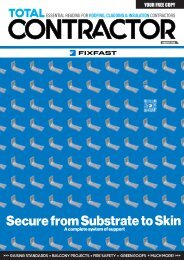October 2020
You also want an ePaper? Increase the reach of your titles
YUMPU automatically turns print PDFs into web optimized ePapers that Google loves.
THE HOME OF
METAL GUTTERING
(QUITE INTERESTING)
INSULATION FA
ACTS
By QI (Quantum Insulation Ltd)
COPPER
PER
ZINC
Online ordering -
pay securely by
credit card or PayPal
Next day delivery on
a huge choice of
stocked items
quotes and
technical advice
Unrivalled
customer service
The 31st August 2020 was an important day for the external envelope
industry. It was the day that BS 8579:2020 Balconies and Terraces
was published. Why is this document so important you may ask? Put
simply, even though it is only guidance it is being looked at as THE
document that unlocks the confusion over exactly what a balcony is,
attachment’ within Approved Document B Regulation 7.
If you haven’t had a chance to read this important new British Standard
yet the answers are;
• Projecting open balconies, projecting enclosed balconies, recessed
open balconies and recessed enclosed balconies are all balconies;
whether thermally broken or cantilever.
• Recessed open terraces, recessed enclosed terraces and access terraces
are all roofs.
• Terraces are roofs, but have a slightly different requirement depending
exit route.
0800 644 44 26 www.rainclear.co.uk
Not any clearer? The simple way to remember the requirements are
“if it’s over air it’ s a balcony” , “if it’s over heated space it’s a roof”.
So, if it’s classed as a roof on a relevant building to demonstrate
compliance with the requirements of Approved Document B the
installed roof system must be either tested to BS EN 13501-5 and
2000; loose laid gravel with a thickness of at least 50 mm or a mass
2
cement screed to a thickness of at least 30 mm, or cast stone or
mineral slabs of at least 40 mm thickness. However, in reality, most
the build-up, unless insurers require otherwise.
If it’s classed as a balcony (built over air) the entire build-up, apart
something called ‘non-combustible’.
This includes the insulation
Regulation 7(3)(g).
Next month’s QI by QI – ‘Correct Wa
ater Flow Reducing Layer (WFRL)
installation’
OCTOBER 2020 TC 59

















